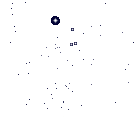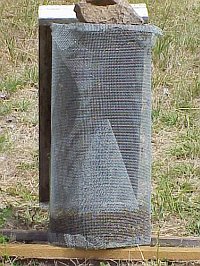The bees of Singing Falls
I am especially fond of bees because of their amazing ability to change a dry hole in a tree, a wooden box or a nook in some rock into a treasure store. Elegant simplicity! How incredible are the ways of God to give these tiny creatures the wisdom to gather the essences of the vegetation around them and to turn a simple wooden box, so frail a structure, into their trusted home. I have seen them reject such man made crevices to be sure. But if they sense that they can keep themselves warm and dry, and their stores from spoiling, there they are contented to stay. The real sustenance of the hive is the fields, trees and seasons. If in the spring they find food sources to sustain and propagate themselves, they are home. Other thoughts the mystery of their ways are on my "Bee Thoughts" page.
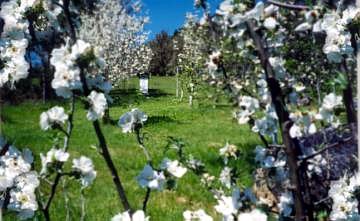
Spring blossom in the apiary orchard
Bees are great and wise. They work very diligently to gather nectar and pollen for the winter months to keep the hive alive and their species assured. Often I have spent hours observing them, marveling at the ability of these little creatures to glean many pounds of the nectar essence of flowers, which brims with vitality. Each year they gather all they can. They do not cease their labors when a sufficient amount of honey is gleaned to sustain the hive. They gather all that their home can hold and that the fields can supply based on the worker bee numbers. This great surplus of honey is what we harvest.We make sure they have more than they need to keep them strong and the hive morale high. The mood of a hive is a very important element. What little I know of them assures me that I must deal gently with them. Normally they do not demand a lot of attention in their care but in recent years great plagues have all but wiped out the feral bee populations.
Another troublesome creature in our particular area is the yellow jacket. These marauding creatures have an important role to play in nature. Often I have observed them in our garden hauling off caterpillars or various other garden pests. But in some seasons they have been known to be out of balance and to turn by the many hundreds against the bee hives. During those years we use this simple wire mesh cone device with a meat bait to capture them.
Many honey producers have gone out of business. Various mites, beetles and diseases imported from other nations have ravaged the bees. New techniques of bee management are being developed by the agricultural industry to sustain bee populations for the essential work of pollination. No pollination equals little or no fruit and vegetables. We are interested in using no harmful chemicals to control these problems and have discovered through internet resources various means of doing this. If you know of any successful method of keeping the bees healthy please let us know. It is hard for me to imagine a homestead without bees. They are important to a sustainable system of life on the farm and in the forest.
At present we are using essential oils derived from various herbs to manage mite infestations. Another powerful tool in the battle against the plague of mites is called "small cell foundation". Reports of success are coming of using this method which reduces the hive cell size and literally cramps the life cycle of the mite. The forum at www.beesource.com is a great place to tap into the wisdom of years of experienced bee keepers
Experiments are being done as we speak with various mite resistant strains of bees. Some bee supply companies have been diligently working since the mid 1990's to cultivate strains of bees from wild survivor hives. These are some of the options we are hoping to try in the future.
During several excursions deep into the forest during the Summer and Autumn of 2006, I found to my great delight, several honey bees hard at work gathering nectar. These are survivors strains of bees. And it is the first of them that I have seen in this area for many years. Perhaps it portends a healing trend in the forest.
It is also very encouraging to me having had several years when the bees had been totally destroyed by bee mites and be viruses. Perhaps the bee kingdom is emerging out of a great darkness.
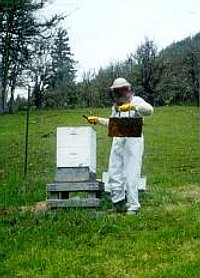
Tending hives in the spring
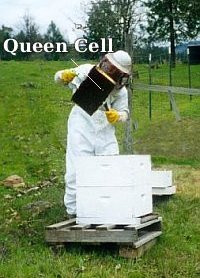
Uh Oh A queen cell ready to hatch
This picture is of my April bee hive inspection of hive #1. Everything looks good for the on coming season. The varroa mites have not killed the hive out. I know many bee keepers who do not use a bee suit or net over their heads and I have often handled the bees without these but generally I suit up to avoid a mishap (which I haven't had so far). If you have the equipment - use it. Bee keeping equipment is very expensive currently. It wasn't always so. If you are unable to purchase used equipment (as I did) study the inexpensive Top Bar Hive plans that I have drawn. This will cut way back on the cost of the actual hive which is also expensive. It will take time and skill to use this kind of hive but some claim considerable success with it.
Above is a picture of hive #2. I started this hive by dividing hive #1 in an attempt to prevent swarming of the bees. Bees divide their hives in the spring. It is their way of propagating the species. Proper management is supposed to prevent this swarming tendency so the hive is large and strong for honey production. Ha! My bees do not read the books. I divided the hive and BOTH hives swarmed. I very carefully clipped the wings of the queen in hive #1. When the bees swarmed they returned to the hive because the queen couldn't leave. The hive is very strong now. It is June and the main hive has created FIVE new hives! My wild strain of bees likes to swarm, I guess. Four of these hives are very strong already and the fifth seems like it will follow suit.
I call the first image on this page "Bee Heaven". Our fruit orchard is beginning to mature. Spring of 2001 was very mild and there was an abundance blooms. In the above picture there is a pear tree, cherry tree and an apple tree in full bloom. Hive #1 is nestled in the upper edge of the orchard. Our wild plum trees bloom very early and if there is a break in the spring weather the bees go with gusto for the early nectar. It is very aromatic. Out of the dreary overcast of winter comes a flood tide of perfume. The wild plum pulls up from deep in its roots all of the life with its components that have been stored in and around its roots from last fall. The bees smell and see the richness welling up from the earth and scurry from flower to flower encouraging a harvest of the cherry sized plums. Dandelion blossoms are very important this time of year also, providing the bees with a nutritious dose of fresh pollen. If the weather breaks in February with a little warm spell, the bees vigorously gather incense cedar tree pollen to enhance brood rearing.
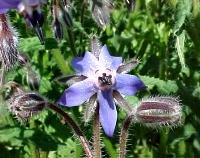
The bee balm flower dispels melancholy
Our bees have a long harvest season. As mentioned before it begins in mid March (weather permitting) with the wild plum bloom. Next comes the apple, cherry, domestic plums and pears. Shortly following is the "Bee Balm" bloom.
The bees love this herb which is also called Borage. Along with many other herbs in the garden, the bees "work" the chives and the clovers that are spread over the place. Soon the oaks and fir trees will be abundant sources of pollen. In early summer all the way to early fall, acres of mint and pennyroyal come to full bloom. During this time also, millions of visits will be paid to the prolific supply of various types of blackberry plants. Mainly the Himalayan blackberry. There is also a tremendous supply of wild forages for them in the surrounding meadows and forests, which includes poison oak blossoms and chicory blossoms. The coniferous trees supply plenty of substances for the creation of propolis. They know not the property boundaries men have made so they do much to fertilize our neighbors' flora also. The honey is a dark rich red color and extremely pleasant to the taste. I only plan on having 4 or 5 hives. Enough for Alexandra's sweet tooth, medicine, the making of our yearly fruit wine supply and some to give away. Last year our single hive gave us 56 pounds of honey.
This is the herb garden very early in the spring. Sage, Rosemary, Lemon Balm, Horehound, Poppies and many more delicacies provide the bees with a wide array of choices to enrich the pollen and honey stores.
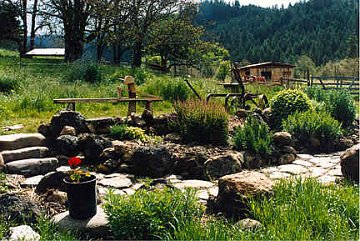
The herb garden in its prime
The Top Bar Hive
In my studies with regards to bee culture I came across a method of bee keeping that uses a hive called the Top Bar Hive. It is used in many third world countries and it is especially suited for those who are interested in living off the land or hobby bee keeping. It lends itself to a work intensive but inexpensive use of readily available equipment and materials. There are several resources available on the WWW dedicated to this subject so I won't burden you with anything other than the actual plans and some links to build your understanding of this genuinely unique technique.
Next is a piece of computer graphics art work created around a picture of one of the bees working a dandelion. The children of Israel were promised that they would enter a land flowing with milk and honey. Honey has always been a sign of the wealth of the earth in a blessed land. When there is an abundance of it, the elements of nature are in balance. The only exception to that rule is in the case of the proliferation of various "noxious weeds" like Russian Knapweed or Star Thistle. These plants produce copious amounts of honey but scourge the land with chemical excretions that prevent other plants from growing. Often it is the bees that turn such uncontrolled imbalances into something useful. A rainbow of hope in a storm.
If you are stuck in a cubicle somewhere in inner city New York or some other major metropolitan area, please take the time to look over our Gallery of Bee Images now and then. Wouldn't we all like such an occupation?
Far out thoughts and interesting information on bees can be found on the "Bee Thoughts" page.
TOP
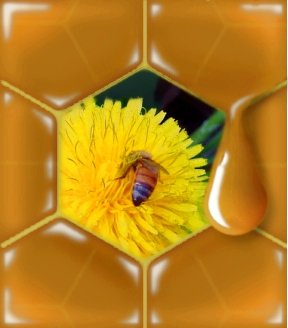
A bee's life


